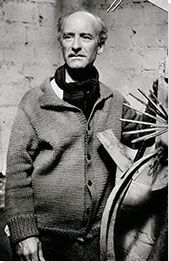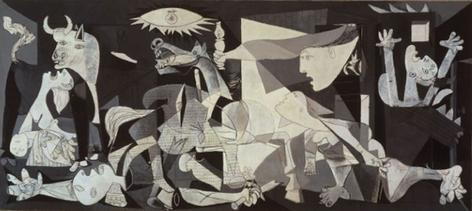Summary of Julio González
Despite Julio González's late start and short creative period of work, marked by poverty and war, he realized key works that capture his radical approach to sculpture. The strong ties to the local craft traditions in Barcelona informed his image of form and his choice of material with the formidable training and his acquired welding skills during WWI allowed him to combine fully contradictory concepts of the modern - from Cubism, Surrealism, Constructivism, to various forms of abstraction - in his sculptures. And especially influential was González's intensive collaboration with Pablo Picasso. Although González never gained broad popularity, he is known as the father of iron sculpture and is consistently included among the famous modern sculptors of the 20th century, such as Brancusi, Giacometti, Laurens, and Picasso.
Accomplishments
- González chose iron as his metal of choice, because of his objection to its modern uses for munitions and for society's mechanized, scientific environment. He aimed to transform this metal into evocative forms. The method of collage informs his process of welding together disparate pieces of metal, even found scraps of metal and bars, creating arabesque-like delineations in space to capture the human experience of beauty and defiance.
- González, inspired by Rodin, left visible the process of making, such as chasing the subject out of the metal, the marks of beating the metal into shape, or showing the skeletal elements used in welding a piece together. The material's unfinished, rough surface or scrap iron pieces expressed the object's corporeality and lent it an emotive quality, which was intended to shape the viewer's perception of the work. For the first time, González used welded metal as a new medium and technique for sculpture.
- Influenced by Picasso's revolutionizing attitude toward the dialogue between painting and sculpture, González began to depict forms in space in his own sculptural work. He therefore understood space as a new material to manipulate and to construct with. This led eventually to González's own invention of drawing in space, which meant using the given lines and surfaces in the material to create open constructions in and with space suggestive of the female figure or human body.
- Drawing provided González with the opportunity to try out his ideas and even occupy himself, when sculpting materials were scarce. They reveal his sense of color and the importance of light and shadow in the composition of spatial form.
- González's Catalan roots led to his deep connection with the Republican cause in Catalonia and Spain's defiance against the fascist threat. His pessimism toward the Spanish Civil War colored his political sympathies, which can be seen in his drawings and sculptures.
Important Art by Julio González
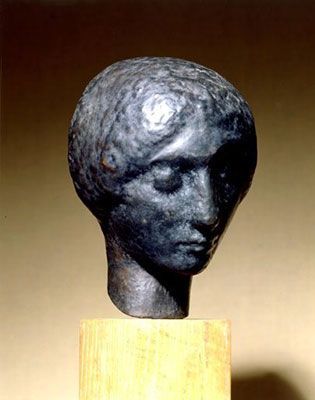
Leaning Head
Gonzalez depicts the introspective mood of a young woman through the way her head leans forward, her calm facial expression, and her closed eyes. He draws upon his technical expertise in repoussé in these early small busts. This metalworking technique allowed for greater plasticity, as can be seen in the shape of the woman's head, an enclosed globe, the soft modeling of her face, the texture of her hair. The palpable sense of form not only anticipates his abstract, cubist heads of the 1930s, it also evokes Rodin's emphasis on corporeality. Gonzalez thus took his first step towards dissolving the fully plastic round volume into geometric form. He would rely more and more on the viewer's perception to associate the abstracted forms, a globe (head) and cylinder (neck), surfaces and lines, as referencing the head, face, or figure of a woman. Yet parallel to Rodin, Gonzalez reveals his process of making. He leaves exposed the marks of beating the metal sheets into the shape of the head to capture a simple human moment, a young woman lost in thought.
Beaten copper, wood base - Peter Nahum At The Leicester Galleries, Mayfair, UK
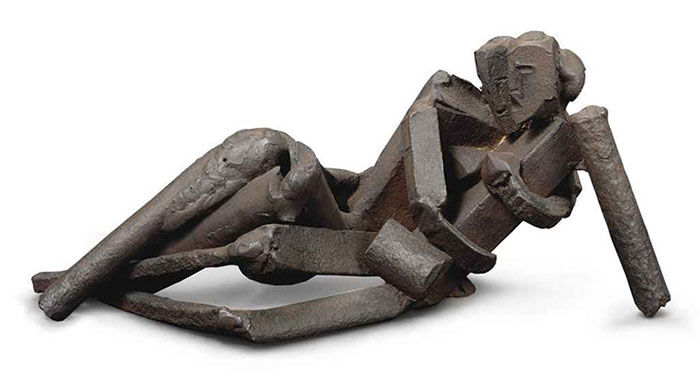
Le Couple
In this small sculpture, only 7 1/2 inches long, a couple reclines, embracing each other. Yet, these figures are essentially abstract forms. It is the sense of interlocking and enclosed spaces rather than volume that contribute a human quality to these forms. The linear and geometric surfaces of the welded unmodified scrap iron pieces make apparent the influence of Cubism; the way scrap iron bars become arms and legs, flat slabs become the torso. The stylized heads reflect Gonzalez's fascination with the Etruscan couple reclining on a sarcophagus that he studied in visits to the Louvre. The influence of Luca Cambiaso, an Italian 16th-century artist who often sketched human figures geometrically, reducing them to cube forms, can also be seen in the work. The spatial construction of line and surfaces create a feeling that these two figures, this couple, are not only welded together physically, but emotionally.
At the time he created The Couple, the artist also made a similar sculpture of a woman alone, a work that was purchased by the American painter and art dealer, John Graham. Graham was a friend of David Smith, the American sculptor whose first works of forged sculpture in 1933 included a figure based upon González's reclining woman.
Forged iron - Private Collection
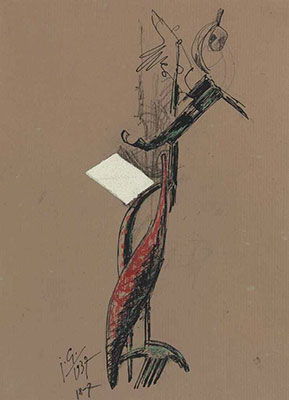
The Woman and the Mirror
From a series of approximately ten drawings, this collage-drawing depicts a female figure with red spiraling curved legs that connect to a penciled skeletal torso supported by a thick inked black line that rises and contracts into a thin line to intersect with a sketched winged right arm. The figure's left arm is delicately hinged and held in place by a line extending out to suggest a shoulder. This same line defines the curve of the neck that ends in a circle for the head with two black dots for eyes. The left arm extends forward in a bold gesture, underscored by its wide, black and green curving shape. At its extremity, a hand seems to curve upward in the gesture of holding something. A white rectangular paper, symbolizing a mirror, hovers near the left hand.
This drawing of a woman and mirror comes closest to the sculpture he welded in iron of the same name. Gonzalez's sketches of a woman and mirror show how the artist continuously drew from his experience of reality, continuously putting his ideas on paper and then, realizing them in abstract sculptural forms.
In contrast to his sculptures, Gonzalez's drawings can be seen as a "visual diary," according to the art historian Valerie Fletcher. The drawings are "the sensitive barometer of Julio Gonzalez's way of thinking," as the art historian Josephine Whiters has commented. Gonzalez precisely dated most of his drawings with day, month, and year, unlike his sculptures that he left undated. In general, these studies in color only present visual exercises that have a tangential relation to the realized sculptures. They serve instead as a laboratory for Gonzalez's creativity, especially during the onset of the second World War when welding became impossible due to the scarcity of materials and supplies.
Collage with pastel, pen and india ink and pencil on paper - Christie's Auction House
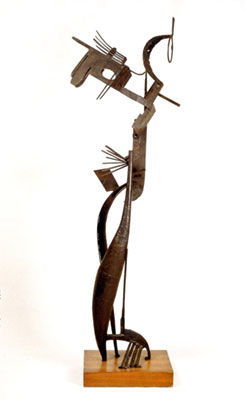
Woman with a Mirror
In this work two curving pieces of metal, one with a foot like extension with five toes reaching back, rise into a long slab of metal that lifts to a round metal circle on the right and a rectangular metal box on the left. This ensemble of curved lines and surfaces articulates Gonzalez's practice of interrelating his drawing and sculpting (welding). His work in the mid-1930s became strikingly abstract and remarkably open, as welding allowed his metal sheets and rods to be like lines drawn in the air.
From the beginning, much of González's work focused on the female figure. As the art critic Hilton Kramer wrote, "All of the motifs to be found in the great open-form sculptures that he produced in the 1930's - heads, dancers, women combing their hair, looking in mirrors - are not only representational but altogether traditional." The artist also seems to have had traditional views of women - as objects of beauty, as mothers, or, as this work shows, as sexually aggressive. The viewer has to piece the figure together visually to see the archetypal femme fatale represented with a mirror: perhaps, two curving legs, a foot arched with extended toes, a plate of iron for her torso, a bar for her neck. Using only figurative references, the work schematically depicts a woman preoccupied with her beauty and charm.
Iron, cast, welded - Institut Valencià d'Art Modern, Valencia Spain
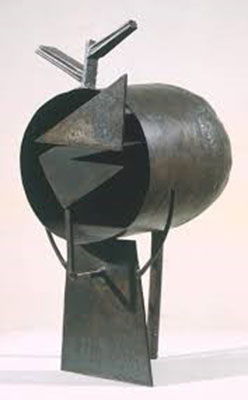
Head Called a Tunnel
This sculpture is made of a cylinder resting upon a trapezium to which it is connected by thin curving bars on both sides. Another thicker bar of metal connects the base of the trapezium to the base of the cylinder. Steel triangles are suspended in the opening of the cylinder, and a bar with two angular arms rises out of the top. It reveals Gonzalez's artistic maturity, resulting from his two year collaboration with Picasso (1929-30).
From his earliest works, González primarily focused on the human figure, yet in this work, only the title definitively indicates that we are meant to see, a human head. Working in steel let him create a three-dimensional form without needing to fill its volumes, as he said, "drawing in space." Space makes the head into a tunnel, where the suspended triangles suggesting facial features almost resemble weather vanes, a visual humor reinforced by the bar at the top like a lightning rod disguised as a hat. Though not part of the Surrealist movement, the artist sometimes showed at Surrealist venues and felt an affinity for their visual puns. Like the Surrealists, he understood that used, everyday objects and materials could offer more expressive qualities to a work, once separated from their utility. The juxtaposition of different materials and objects in unreal and strange connections opened up the possibility of creative expression in contradiction to the predictable modern mechanized world. González worked the found material: forming, cutting, designing, and bending it, before collaging it into the figure. The small curved bars could suggest arms, as if the figure were holding its head in both hands. What is conveyed is a kind of hollow modern sensibility, filled only with the changing winds of public opinion. The human is no longer recognizably human, but functional. As art historian Jörn Merkert commented, "All damaged and injured are kept - scrap remains scrap - and at the same time González gives a special validity back to this injured material of the everyday and working world." The facial features, like the suspended triangles, are an abstract construction of surfaces and lines, yet suggest human fragility in their precarious construction.
Steel - Collection of the Tate, United Kingdom
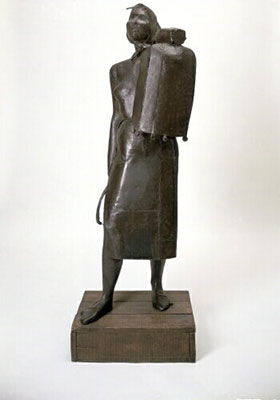
La Montserrat
This significant sculpture depicts a peasant woman, holding a child in her left arm, and a sickle, a traditional agricultural tool, in her right hand, as she steps forward resolutely on the wooden base and looks up toward the sky. This modern madonna and child references the Madonna - the "Black Madonna" at the Monastery of Saint Montserrat - as well as the Catholic faith at the heart of Spanish culture. The life-sized sculpture is uncharacteristically naturalistic, and reminiscent of Gonzalez's oil painting, Peasant Woman Sitting (1919-1920) that depicted a peasant woman in similar dress and holding a sickle. The title of the piece refers to the Montserrat mountains near Barcelona, a traditional symbol of the artist's native province of Catalonia, and is also a common name given to women from the area. The sickle was a symbol used in the Revolution of 1936, at the onset of the Spanish Civil War, when the province defeated the Spanish Nationalist rebels who attempted to overthrow the left-wing Popular Front Spanish government.
At the 1937 Paris World Fair, the work made a powerful statement, exhibited alongside Picasso's Guernica, created in response to the bombing of Guernica, a Basque country village in northern Spain, by warplanes of the Spanish Nationalist rebels' allies, Nazi Germany and Fascist Italy.
González's representation of a defiant motherhood conveyed his anguish over the Spanish Civil War, which led him to create a monumental figure as a heroic symbol. Cutting, and then welding together pieces of sheet metal, he depicts an ideal woman in naturalistic form. Further, it almost seems the woman is a classic warrior, with shield and sword. She is identifiably a Catalan peasant woman, but the resulting volumes, the child depicted by the cylinder of its blanket, and the lack of detail, make her the archetypal mother of the country. González revisited the figure in later works.
Welded and wrought iron, wood - Stedelijk Museum, Amsterdam
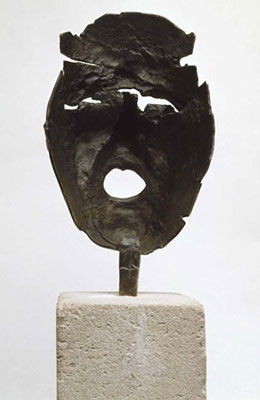
Mask of Montserrat Screaming
In this work, made out of scrap metal, a dark mask with its eyes formed by ragged openings and its edges torn opens its mouth in a scream that captures the universal expression of despair and anguish in the face of a duplicitous and unjust civil war.
González's work meant that it could be assimilated into very different art movements but not defined within any of them. His mask evokes the Expressionist artist Edvard Munch's The Scream and the artist Francisco Goya's The Disasters of War series, and yet spoke to his contemporaries in the art movement of Constructivism and abstract art. Having learned how to weld in an armament factory, he knew well how iron is commonly turned into weaponry and said, "It is time this metal ceased to be a murderer...Today the door is wide open for this material to be, at last forged and hammered by the peaceful hands of an artist." Here he revisits La Montserrat as his heroic peasant becomes a broken face expressing the anguish of the Spanish Civil War. Creating the piece directly at the forge, he used a torch to create the mask's surface texture, which is blackened and cracked by fire, to convey how humanity is broken down by war, much like a fragment left over from an explosion.
Bronze, lost-wax casting and patinated - Museo Nacional Centro de Arte Reina Sofia, Madrid
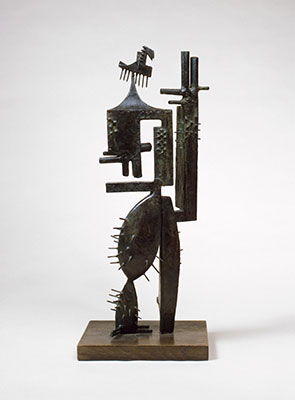
Cactus Man I
This sculpture depicts a humanoid figure with cactus-like legs, a five-fingered arm rising vertically from the hip, and a tubular torso rising to a hat-like head. The left arm is a kind of drum with five fingers above a horizontal phallic bar. Metal nails erupt from the figure, like cactus spines, influenced, perhaps by the use of nails in Picasso's 1926 Guitar. This defiant, prickly figure symbolizes the republican cause during the Spanish Civil War.
His subsequent work Cactus Man II, sometimes called "Madame" Cactus, personifies the Catalonian peasant's resistance to Franco's fascist threat. At the time both pieces were conceived, Catalonia was under attack by Franco and his fascist Nationalist rebels, and, by the time both were finished, Barcelona had been defeated.
During the late 1930s, González's work in the abstract style, like Cactus Man I, had a major influence on avant-garde sculpture. The human figure is synthesized with the cactus to connect the Spanish peasant with the land. Like the cactus, the peasant has the ability to survive harsh conditions and to protect himself. With a sense of humor, the nails resemble both cactus spines and whiskers, and the tiny head is quixotic. The short tubular fingers look like gun barrels, and both the arm rising vertically and the drum on the left resemble machine gun housing, so that the figure seems both armed and armored. In some preliminary drawings, the artist depicted the figure as screaming, but in this finished work he conveys a presence of unyielding resistance.
Cast bronze and iron nails - Museu Nacional d'Art de Catalunya, Barcelona, Spain
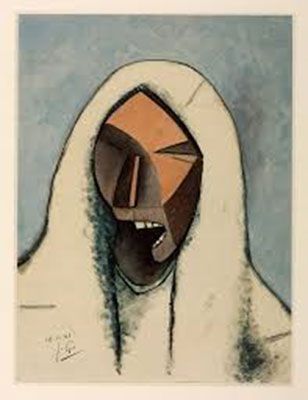
Screaming Head with a White Veil
From April 1941 to May 1941, the artist completed eight drawings of a woman with a veil of which this is the last. The first drawings were more realistic in style, but the later works, as shown here, are agonized and distorted and influenced by Cubism and African masks. Originally wanting to depict the Virgin Mary, he creates a figure, shrouded in white, the color of mourning, to evoke her as suffering the anguish of humanity during World War II. In its focus on a scream, the work revisits The Screaming Head of Montserrat, but the Cubist treatment emphasizes an element of outrage. Divided into light and dark planes, the face suggests a sensibility torn into pieces by conflict, and the mouth depicted in profile seems to shout into the darkest area in the drawing, as if to denounce the impending darkness that would engulf Spain.
Ink and oil paint on off-white paper - Collection of the Tate, United Kingdom
Biography of Julio González
Childhood
González was born Julio González Pellicer in Barcelona to a family descended from a long line of metal smiths. As a child, he began learning decorative metal working in his father's workshop. His father, Concordio González, was a part-time sculptor, and his mother, Pilar Pellicer Fenés, came from a long line of well-known artists, her father having been an important 19th century Catalan illustrator and designer. As the youngest of four children, González was particularly close to his mother and to his older brother, Joan. As his family loved music, he learned to play the mandolin at an early age to accompany his singing. He attended a Catholic school that followed the educational model of medieval craft guilds, where technical training was highly valued.
Early Training and Work
As a teenager, González, along with Joan, took evening classes at the Barcelona School of Fine Arts. He was influenced by the Impressionists, often painting and sketching the female figure, and by Art Nouveau in his decorative metal work. The brothers also joined Circol Artist Sant Luc, an artistic society that advocated humility, Catholic morals in the arts, and the craft emphasis of guilds. Their uncle was the president of this society that included the prominent Catalan artists Joan Limona, Joseph Limon, Antoni Utrillo, and the architect Antonio Gaudi. González was attracted to the society because of the group of young artists, known as Le Cénacle, that he met there. Le Cénacle aimed to remove the distinctions between applied and fine arts and therefore included artists from across the arts: the painters Joaquin Torres-Garcia, Josep Pijoan, Ramon Pichot, the poet Eduardo Marquina, and the musician Antoni Ribera. The group frequented Els Quatre Cats, and would sometimes gather at the González home for informal discussions, and for drawing sessions with a model.
Like many of these artists, González originally wanted to be a painter. He began exhibiting his paintings and metalwork in Barcelona and even sent pieces to the World's Colombian Exposition in Chicago in 1893. However, he was often over shadowed by his older brother, Joan, who took a more active public role as an artist. Art historian Josephine Withers wrote, "..the picture emerges of a shy and sensitive man, eager to become an artist, but uncertain of how to go about it. González appears to have been plagued with a certain hesitancy and skepticism which was to remain with him for many years." As a result of this profound uncertainty, he didn't arrive at his own innovative artistic maturity until he was in his fifties.
In 1898, the death of his father had a great impact on the family. The metal workshop was subsequently sold, and in 1900, his brother Joan, who had become the head of the household, moved the entire family to Paris. In Paris, González quickly became friends with the artists, Pablo Gargallo, Juan Gris, Manolo Hugué, Max Jacob, and Jaime Sabartés. He and his brother Joan also renewed their friendship with Pablo Picasso, whom they had met in 1896 at a Barcelona exhibition. The three men became close friends until 1904 when an acrimonious quarrel erupted. Some of Joan's artworks that had been left in the safekeeping of Picasso's family went missing. Valuing family loyalty over friendship, González wrote to Picasso, "You say you do not want to meet my brother and because of that you do not come to the workshop, now I am telling you: until this matter is settled, for the honor of my brother and me, I forbid you the entrance of my house as of my workshop." The break with Picasso was to last until 1921.
In 1908 after a long struggle with tuberculosis, Joan died. González's daughter Roberta would later write of her father: "Now began ... a solitude that always increased. These eighteen years from 1908 to 1926 were without doubt the most dramatic of his life up to that time. Practical difficulties, mental anguish, above all artistic anguish, the bitter fight with himself over the search for his true personality, were certainly the most depressing things he had to overcome." He withdrew from artistic society and only saw Brancusi, his closest friend, occasionally.
In 1909 he married Louise Berton, a model who was the subject of many of his drawings, but the marriage ended shortly after the birth of their daughter Roberta. To support his extended family he established a Parisian shop, "GONZÁLEZ - Jewelry and Works of Art" in 1915. He sold what he called "antiques from Spain," hats and clothing made by his sisters as well as his own decorative work, made using the metal working technique, known as repoussé. In 1918 at the end of World War I, he worked at a Renault armament factory, where he learned oxyacetylene welding.
In 1922, he had his first solo exhibition at the Galerie Povolovsky in Paris, and a solo exhibition the following year at the Galerie du Caméléon in Paris. At both shows he exhibited paintings, drawings, jewelry, small sculptures, and objets d'art. He worked as a studio assistant to Brancusi from 1925-26, making sculpture armatures and renewed his friendship with the artist Pablo Gargallo who was creating works that used sheet metal cutouts and who wanted González to teach him welding. Gargallo encouraged González to pursue sculpture more seriously.
Mature Period
The late 1920s were a period of radical innovation in González's artistic practice. His friendship with Picasso had been renewed, when they ran into each other by chance. According to his daughter Roberta, "Picasso called out: 'Hey, we are not going to stay angry all of our life! Let's hug each other!'' The friendship became an artistic collaboration in 1928 when Picasso hired González for metalworking. Over the course of the next three years, González and Picasso worked together on six Cubist metal 3D sculptures based upon Picasso's lattice-like drawings. For the most important work they did together, Picasso's Woman in the Garden (1929-30) Picasso found objects and scrap metal, while González forged or cut pieces based upon Picasso's drawings. The piece changed modern sculpture, and influenced both artists. The art critic Margit Rowell explains: ''It was Picasso's first large-scale sculpture...The found elements, as opposed to the carefully cut sections, brought a new and unexpected expressivity to Picasso's art...González, on the other hand, discovered the assemblage principle and the potential force of combining disparate parts...He learned the evocative power of images distilled into skeletal lines and planes.''
During this time, González was also friends with Brancusi, Joaquín Torres-García, Georges Vantongerloo, and Jean Hélion and knew Piet Mondrian, Jean Arp, and Fernand Léger. These artists were often engaged in intense debate about abstraction in art. Participating in these discussions, González was gradually working toward his own sense of the possibilities of metal work and sculpture. Abstraction appealed to him, but he felt also that art couldn't give up nature, as he said that all of his work came from direct observation. His highest praise for an artwork was that it was serious. Characteristically, he still seemed to doubt his own authority, as he asked Picasso for permission to work independently in the manner they had both developed.
In 1929, he made his first noted sculpture in iron, Don Quixote, a figure deeply connected to Spanish culture and, subsequently, began creating the abstract metal sculpture for which he is most known. In the 1930s, while creating the masterworks of abstraction and collaged constructions, González needed to continue making a living as a metal smith. In 1937, he married Marie-Therese Roux, who also helped support the family by bringing in commissions for jewelry and fashion fittings.
Later Period
The Spanish Civil War, particularly as it affected his native province of Catalonia, had a profound impact on him. His work, La Montserrat with its naturalistic treatment of peasant resistance made him known to the public, and the subject matter continued to haunt him. The outbreak of World War II deepened his sense of anguish, as the fascism that had triumphed in Spain became a worldwide threat and a source of personal anguish. His daughter Roberta had married the German artist, Hans Hartung, in 1938. As Hartung was wanted by the German secret police for his anti-Nazi activism, he and Roberta went into hiding when the Germans invaded France. Deeply worried, González focused on his art. As welding materials were unavailable due to the war, he drew extensively and began working on plaster casts for bronze pieces, Most of them were never cast, as he died unexpectedly in 1942.
The Legacy of Julio González
Called "the father of all iron sculpture of this century" by the American sculptor David Smith, González's use of metal and welding revolutionized modern sculpture, and his abstract and linear open forms that he called "drawing in space," had a profound influence on abstract art forms and Constructivism. Most modern sculptors who work in metal are implicitly, if not as consciously as Smith was, his artistic descendants. His influence has been felt internationally in the work of Anthony Caro, William Tucker, Hans Uhlmann, Carel Visser, Eduardo Chillida, Jean Tinguely Roberto Lardera, noted English, German, Dutch, Spanish, French and Italian sculptors respectively. His influence continues into the 21st century, notably in the works of post-minimalist artist Richard Tuttle.
Influences and Connections

-
![Francisco Goya]() Francisco Goya
Francisco Goya -
![Pablo Picasso]() Pablo Picasso
Pablo Picasso - Luca Cambiaso
-
![Constantin Brâncuși]() Constantin Brâncuși
Constantin Brâncuși -
![Pablo Picasso]() Pablo Picasso
Pablo Picasso -
![Juan Gris]() Juan Gris
Juan Gris - Pablo Gargallo
- Manolo Hugué
-
![David Smith]() David Smith
David Smith -
![Anthony Caro]() Anthony Caro
Anthony Caro -
![Jean Tinguely]() Jean Tinguely
Jean Tinguely - William Tucker
- Carel Visser
-
![Cubism]() Cubism
Cubism -
![Surrealism]() Surrealism
Surrealism - Abstractionism
- Constructionism
 Ask The Art Story AI
Ask The Art Story AI